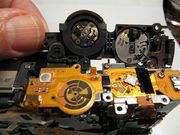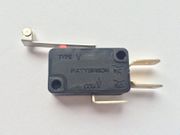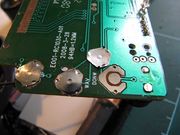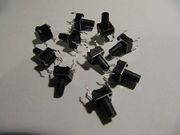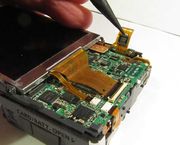Passive components
This page covers passive components: switches, push-buttons and connectors, how to identify them and understand their common failure modes, and how to test them.
Summary
You might think of passive components such as switches, push-buttons and connectors as the "country cousins" of electronics, but they are important, none the less. We discover how to identify them, what they do, how they fail and how to test them.
You can read this page on its own if you like, but if you're not already familiar with basic electrical and electronic theory you my find you get more out of it if you first read Electric circuits, volts amps watts and ohms.
Switches
Switches come in many different forms, and being in part mechanical, they are subject to wear and failure.In its simplest form, a switch consists of two pieces of metal that can be made to touch or not, so switching the current through it on or off. Alternatively, a third piece of metal can be moved to bridge the other two.
Often, a single enclosure will contain two switches operated by the same lever or knob. This is known as a 2-pole switch, and it can be used, for example, to disconnect both the live and neutral in a mains outlet, making the outlet completely safe.
A 2-way switch connects one contact to one or other or two other contacts, diverting the current into one of 2 paths. The waveband switch in an older AM/FM radio might well be one of these. You can also have multi-way switches which can switch up to a dozen ways.
Multi-way switches can also have multiple poles, so for example a 2-pole 3-way switch would be able to switch each of two circuits three ways.
A microswitch is often used in electromechanical devices where a switch needs to be operated for example by a safety interlock or some other mechanism rather than directly by a user. They are designed to operate with very little force and reliably at a particular point. They come in a few standard sizes and hence are easily replaced but come with several different contact configurations. There is also a choice of operation by a lever, or a roller (as in the photo) or directly by the button which is beneath the lever in other types.
Many small switches consist of several springy metal fingers which move across one or more static metal contacts. Sometimes the pressure needs to be increased by bending the springy metal finger. If the contacts are dirty or corroded, they can be cleaned with switch cleaning fluid. In some cases the static contacts are simply tracks on a circuit board, and these can wear through. A solution may be to bend the springy metal pieces to make contact at a slightly different point.
If you try to disassemble a switch be aware that it may contain a spring which can easily take flight and small parts which tend to fall out. This can make it challenging to work out the precise arrangement of the parts and difficult to hold them all in position as you try to put it back together again.
Push-buttons
Push-buttons also come in many different forms but are usually single pole single way (on/off) switches. Most rely on the click effect familiar from the safety button on screw-on metal lids to glass jars of jam, baby food and many other food products. At a critical pressure the button flips from a convex to a concave form. In a push button switch it may be a plastic film or a sliver of thin metal. In the case of metal (as illustrated from a digital alarm clock), it may be this that makes contact with a trace on a circuit board beneath, otherwise a piece of conductive rubber may bridge the gap between two circuit board traces when the button is pressed. In either case, cleaning with isopropyl alcohol or switch cleaning fluid can help.
Small push-button tactile switches may not be repairable but can often be easily replaced. Common types are 6x6 or 12x12mm and various heights. The height is measured from the bottom of the body (in contact with the circuit board) to the top of the button. The 4 legs are connected together in pairs. On pressing the button, a connection is made between one pair and the other. Many eBay sellers offer these at very reasonable prices.
Connectors
Connectors are used not only to connect external devices such as a power supply or headphones, but they are also used extensively inside many devices, to interconnect the various sub-assemblies.
Connectors can often fail if they see a lot of use or are subject to strain or contamination with dirt or moisture.
Dirt and corrosion can be removed with switch cleaning fluid, available in an aerosol can, assisted by gently rubbing with a tissue. Corroded terminals in a battery compartment is a common problem, caused by chemicals leaking from long-dead batteries.
Electrical contact is normally maintained by spring pressure in some form. The pressure may be lost over time and can sometimes be restored by gently bending a springy piece of metal.
Modern electronic equipment often uses ribbon cables to interconnect the sub-assemblies. Sometimes the ribbon can be simply pulled out of its connector and pushed back in on reassembly, but often there is a clamp which must be pulled or lifted in order to release the ribbon. Care is required - if the clamp is broken through being pulled in the wrong direction or with too much force, it may be that little can be done.
A separate page lists many common types of connector, and how to disconnect and reconnect them.
And now ...
... you might like to continue by reading about Protection components.
